How To Set Up Agile Project
Failing to plan is planning to neglect. This quote by the fourth dimension management practiced Alan Lakein perfectly summarizes the importance of planning in project management. As much as we detest fixed dates and stock-still scopes in the Agile world, it is the everyday life for many organizations, and we cannot just ignore its importance.
Fifty-fifty if nosotros get outside the realm of fixed-date, fixed-telescopic projects and dive into the product development earth, planning is nevertheless of crucial importance. Most customers won't commit budget to an open up-ended specification and demand a delivery date alongside the quote.
Assuming such a reality, a natural question to ask is, "How do we create an agile project program?". This is a tough question, and most materials on the topic only cover the software development practise. It creates an impression that Agile is suitable just for the software industry, but nix could be farther from the truth.
Agile Planning is NOT Scrum Planning
Ofttimes you will read that Agile Planning is the aforementioned as Scrum Planning. However, this is far from the truth. Scrum is a prescriptive framework for software evolution that proposes one concrete manner to plan. It is prevalent in the software world, just it is often the subject of astringent criticism.
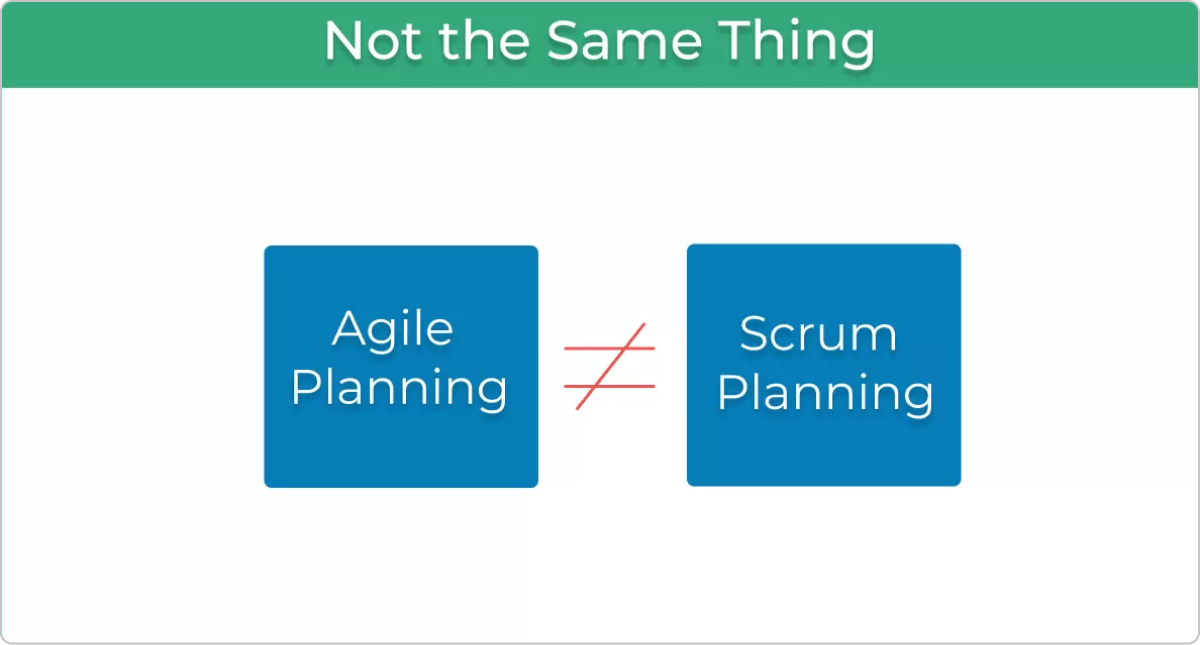
Nosotros won't go into the details of why Scrum planning is flawed, equally we would rather talk about Active thinking applied across various industries and not just software. It is more than important to know how to utilise generic techniques and practices on the global company level, regardless of the business organisation type. For the time being, it is only essential to know that Active Planning does not necessarily involve the Scrum framework at all.
Agile Project Planning VS Traditional Project Planning
In the past, business leaders spent enormous amounts of fourth dimension laying out detailed plans of execution for years in the future.
For a long time, this manner of planning worked perfectly. However, as markets became more dynamic in the last decades of the 20th century, concern requirements began to change more ofttimes, and a new, more flexible way of planning was necessary.
Тhis need became obvious and somewhat disquisitional with the rising of knowledge work. While but l years ago people worked primarily in factories, these days the work gets done in offices, where people employ their heads more than their easily. Information technology is precise noesis work where an Agile project program is most needed.
The chief departure between Active planning and the traditional way (too known every bit Waterfall) is that the first one is iterative and adaptive to changes. In contrast, the 2d i is a step-past-pace heavy planning process.
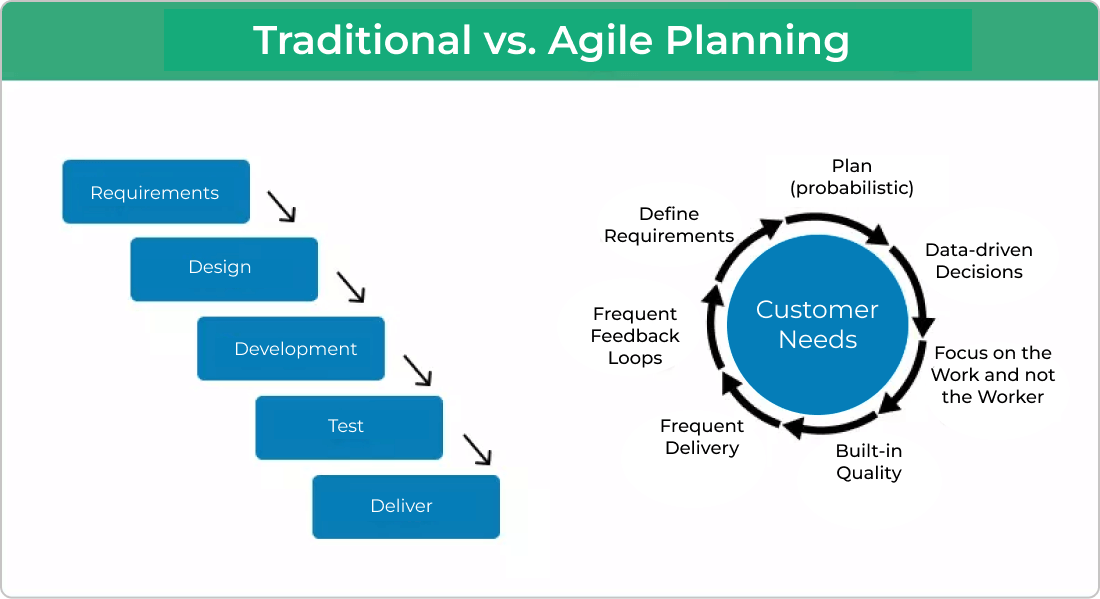
We have to mention that both approaches take their virtues. When yous're building a bridge or a building, you want to have a very detailed and well-thought-of plan. Here, welcoming requirements belatedly in the process with an Agile project programme is not the most suitable approach. Of course, it can happen, but changes might be costly to implement.
However, in knowledge work, change is welcome at whatsoever stage of the procedure, even at the very end. The goal is to create a solution that satisfies customers, and everything is immune. But said, in Agile project management, you lot lay downwards detailed plans simply for shorter time frames, and y'all tin easily make changes when needed.
Characteristics of Agile Project Planning
Start, allow's focus on the different levels at which you can plan. The "Agile Planning Onion" best describes these levels:
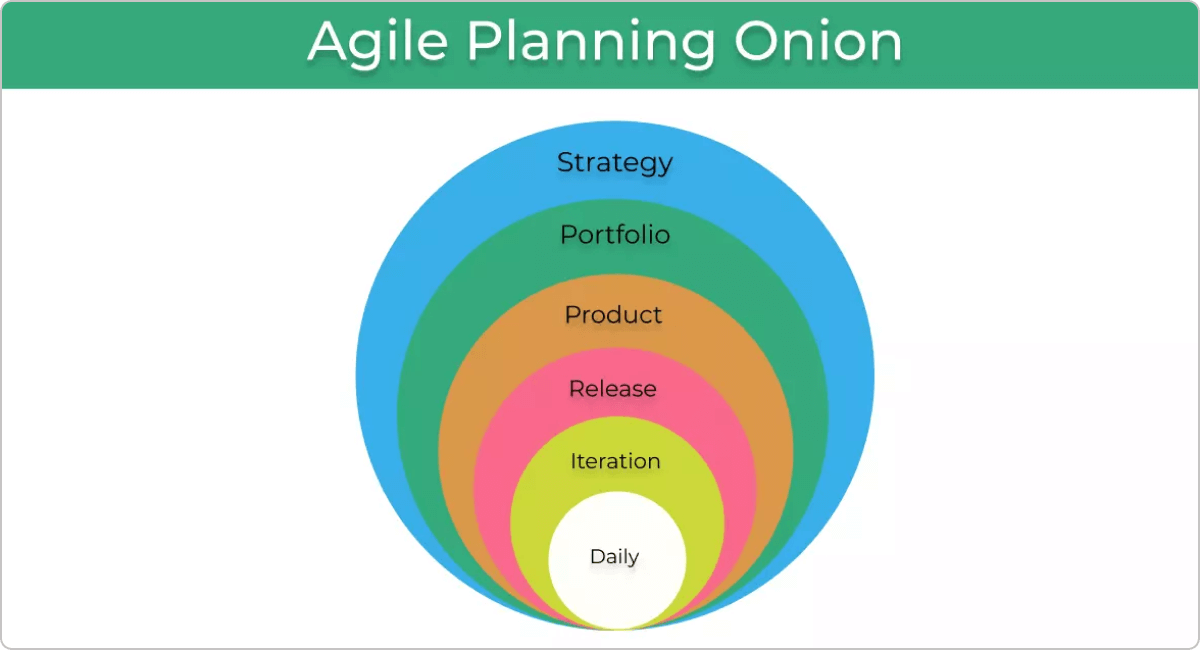
It is fundamentally essential to grasp the idea that Agile Planning is applicable at every slice of the onion. You don't just exercise Agile on the squad level (Solar day, Iteration, Release). Y'all can have an Agile production management service, Active portfolio management, and Active strategy. Being agile in your strategy is what defines business agility in general.
As we already stated only didn't explain, Agile planning is iterative. This means that you develop and adjust your program multiple times, equally you lot find necessary. The goal is to invest time in planning at the best possible moment and adapt to changes easily if they occur during the execution stage.
Irrespective of the level at which you operate, your Agile projection plan will have like characteristics. Let's explore them in no detail order.
- The goal from the eyes of a customer (value)
- Lack of detail whenever it tin be avoided (commit as belatedly equally possible)
- Frequent deliveries (small batch size)
- Date ranges instead of single date estimates (probabilistic vs. deterministic)
- Focus on the work and not the worker (no detail assignees, the team is responsible)
- No separate phases for Quality Assurance (quality is congenital-in)
- Ii-tiered plans (Timelines for initiatives, tasks accept no start/cease dates)
- Data-driven (Based on historical data and Monte Carlo simulations)
The Goal from the eyes of a client (Value)
An Agile plan must consider what exactly the client wants. If we need to infringe a term from the Lean lexicon, we will use the give-and-take Value. In other words, our plan must exist clear on how and when we are going to evangelize value to the customer.
In this regard, the more than the plan is focused on outcomes, the meliorate. If you are used to putting activities inside the plan, recall again. Is it crucial to know what people do or what value they have produced?
Lack of detail whenever it can be avoided (Commit as late as possible)
Imagine you lot're preparing for an expedition to a high mount that hasn't been explored earlier. You will accept a rough estimate of the duration of the trek to set up plenty food and water. Nevertheless, you won't know if there's a place suitable for camping and where that place might exist at all.
Many projects in the knowledge work realm are quite similar to the described trek. You know a lot almost the project in advance but not plenty to commit to every single piece of it. Still, many managers insist on having a strict, detailed programme for every single projection deliverable. Interestingly, we are offloading the commitment to the last responsible moment in existent life, merely we fail to do and then in our project plan.
Frequent deliveries & fast feedback loops (small batch size)
An Active plan should adapt for frequent deliveries and make the drove of feedback explicit. Indeed, the feedback taken should exist reflected in the side by side version of the plan, which would better the likelihood of successful projection closure.
Projects are big batches of work past definition. However, there is no obligation to deliver them all at once. Most customers would want to take an early preview of the results to ensure that the project does not deviate as well much from what they await.
Suppose the project team misunderstood the requirements and set off to work on something completely unlike from what you envisioned as a customer. Would yous rather requite them feedback early on or wait until the projection borderline? It is more than natural to give feedback early in the cycle and prevent wasting precious time and resources.
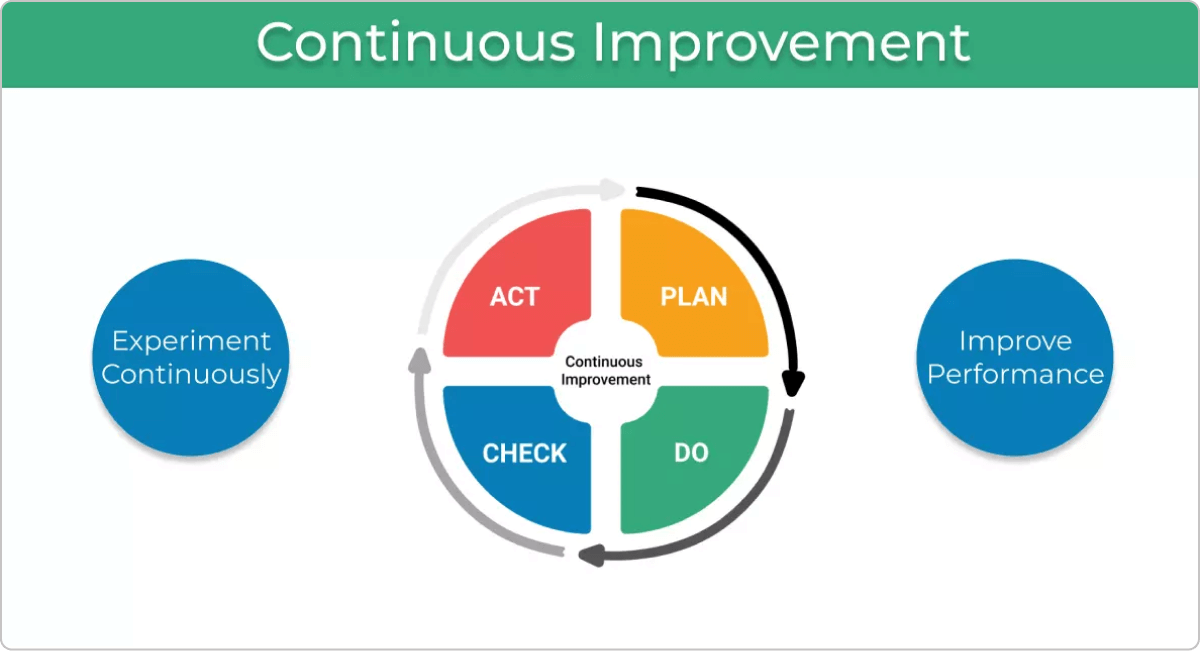
Date ranges instead of unmarried date estimates (probabilistic vs. deterministic)
When customers ask near the projection duration, they ordinarily expect a fixed date. Just you would be surprised how many customers would actually approve if you provide a date range instead of a single date.
As they say, information technology's better to exist roughly right than to be precisely wrong. And this is what we would encourage everyone to do – use engagement ranges based on historical information and forecasting methods to create an Agile projection timeline for your plan.
Focus on the work and not the worker (the squad is the owner)
This comes from the aforementioned perspective as the tardily delivery case. If you assign people to the jobs too early on, you're risking to practise the wrong matter at the wrong time. From the perspective that nosotros care about the flow of piece of work and not necessarily utilizing every worker at 100%, it'southward OK to go out the squad to self-organize effectually the project.
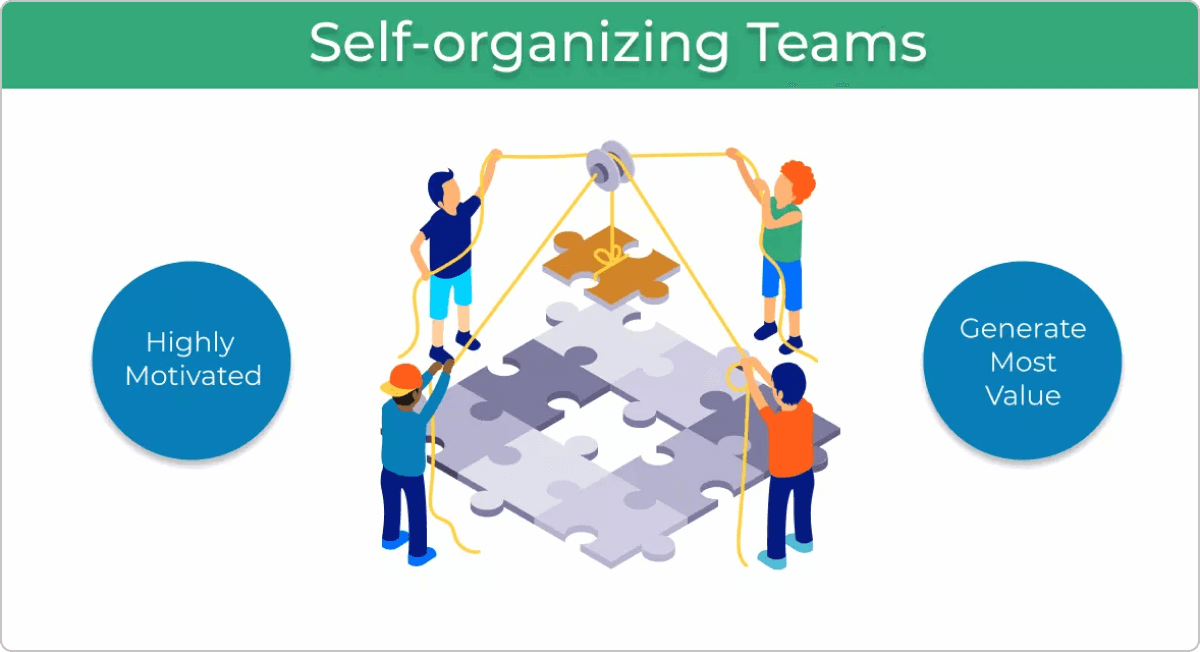
It is virtually certainly true that you lot have specialists on the squad, which creates many dependencies, especially in larger companies. An Active omnibus'south natural response would be to eliminate the dependencies, just this is an respond detached from the real earth. You can't just remove all dependencies without creating a ton of bug elsewhere in the system.
The reasonable arroyo is to manage dependencies coming from the holistic view of your system and value streams. If the flow of value to the customer is blocked because of team Ten, and then that's where you should be focusing on, even if it ways that team Y will have nothing to work on.
This is a chip radical and requires a paradigm shift, simply information technology'southward a fundamental concept in Lean and Agile project planning. It'southward needless to say that in such situations, your plan has to reflect the focus on block/issue resolution with less focus on employee utilization.
No separate phase for Quality Balls (build quality in)
Toyota became the biggest machine manufacturer in less than 50 years, starting from a small family company. One of the principles they used was "Build quality in", which means that no time should be spent fixing the product later on information technology has exited the product line.
It would be best if you strive for the same level of quality during the execution phase of the project and, past whatever means, try to avoid a terminal "Quality Balls" stage. If yous accept a big final quality balls stage, you've most probable ignored the quality aspect throughout the projection life bicycle, and once you become into the quality phase, things start to await ugly.
Of course, it's better to have a final quality check instead of aircraft a defective product, only this should be an exception rather than the norm.
Two-tiered plans (Plan only the initiatives and non the tasks)
his is i of the essential characteristics of an effective Agile plan. If you lot have a loftier-level plan of all major deliverables (initiatives), information technology'south easy to break them downward into tasks and then pass the tasks to the actual execution teams.
While this might sound fiddling, it represents a substantial deviation compared to the traditional Gantt nautical chart plans. When you break down an initiative (project deliverable) into its comprising tasks, we recommend that no start and finish dates are determined for the tasks unless necessary.
For example, a task representing the creation of posters for a concert would exist useless later on the concert, and then it must accept a deadline attached to it. However, mostly, tasks won't have any real deadline.
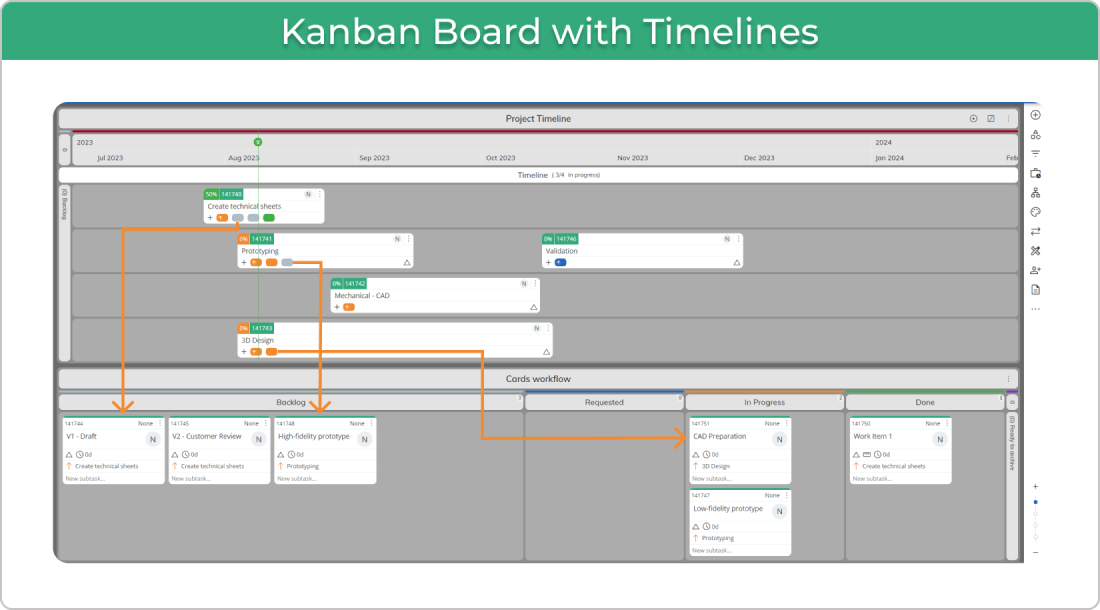
When you skip the start/end dates for all individual tasks, you allow your teams to pull new work when they have the capacity and non when you thought they should have the capacity. The word PULL here is used on purpose, as it illustrates the PULL principle that we know so well from Toyota.
The fact that you put start and end dates to the initiative but leave out the dates from its children tasks detaches the planning from the execution. This way, you maintain the Agile project program in terms of time and commitment, but y'all permit your teams to make the optimal decision, as they are the ones closest to the work's technical details.
Information-driven decisions (apply your historical data to programme the time to come)
If you lot use the Kanban method to run the day-to-mean solar day tasks in your teams, information technology is easy to utilise statistical methods for data-driven forecasting. One such method widely used in the Agile earth is the so-chosen Monte Carlo simulations.
The Monte Carlo simulations take every bit input historical data (throughput and cycle time). And so, with the help of mathematical algorithms, simulate thousands of possible outcomes for your project. Subsequently assessing all the possible outcomes, the Monte Carlo simulation provides information virtually the project'due south potential completion dates with some probability attached to the forecast.
For example, a Monte Carlo simulation can forecast an 85% probability that your projection volition cease by the 2nd of July. Alternatively, the forecast tin tell you that there is a 95% probability that you will deliver 200 tasks or more by your deadline. This gives a good indication near the project status, and it's based entirely on statistics, which tin relieve you the trouble of estimating all tasks 1 by one.

ten Years Kanban Experience In 1 Free Book:
Project Director's Guide to Kanban
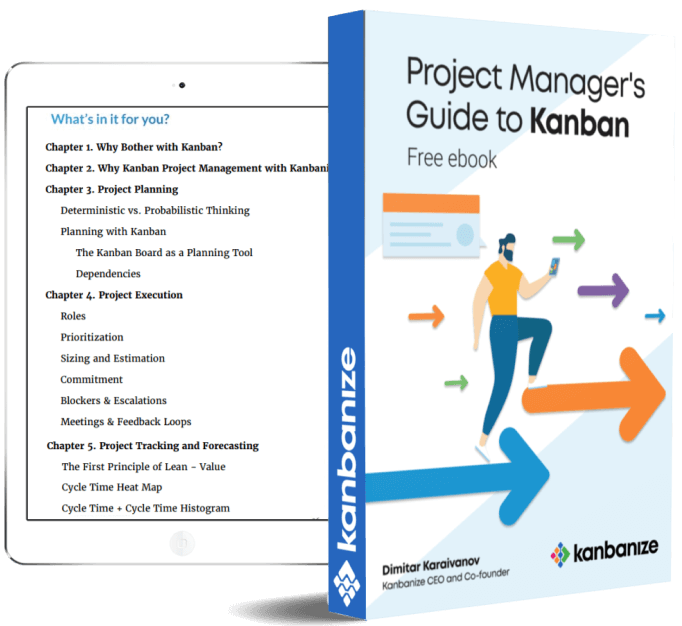
Tools like Kanbanize combine this thought with the previous one (ii-tiered plans) to create a continuous forecasting organization that informs managers of all projects' actual condition and their deliverables. Kanbanize extends this type of continuous forecasting to the portfolio level, equally information technology'southward easy to see a real-time forecast of all projects in the portfolio. All you need to practise is run the day-to-24-hour interval tasks in a ready of team Kanban boards and connect them to the parent projects.
Agile Project Plan Instance
As we've already discussed Agile planning characteristics, let's look at a practical example of building an Agile plan and how nosotros do it at Kanbanize.
Defining Major Project Deliverables or Releases
Allow's say nosotros have to programme the creation of a new website. As the telescopic for that is quite big, the first thing that we would do is ascertain dissimilar functional parts (deliverables) that will exist continuously released to the market.
Here, we should note that we won't plan the deliverables in particular. An Agile projection plan leaves this for the "last responsible moment" and includes it progressively throughout the projection. This will salve the states the otherwise wasted time of unnecessary planning and help us retain agility for any emerging changes.
To build a roadmap for the execution of the deliverables, you can utilise an Agile project timeline. In Kanbanize, for example, nosotros use a Kanban timeline (equally seen from below) to reach that. Y'all tin can so input one or more of the deliverables to be executed in parallel or visualize a sequence when some of them are dependent on one another.

Breaking Down Into Tasks
Once we have the major functional parts of the projection visualized in a roadmap-like view, our next step would be to break them down into individual tasks. As nosotros progressively elaborate on our Agile plans, we will start with the most disquisitional deliverables at this point.
To visualize the tasks and their flow to completion, you tin can employ a dedicated Kanban board. In Kanbanize, we connect the Active timeline containing the project roadmap and the Kanban board, as seen below.

This gives an unmatched view of the entire project progress from concept to fruition. Equally a result, we can encounter which deliverables are currently in progress, their status, and who is working on what at whatsoever given moment. This setup also allows u.s.a. to interact with 1 some other when tasks go stuck in the process and resolve the issues faster.
Through the concept of "just in fourth dimension" planning, we can retain agility for whatever last-minute changes, emerging requirements, or shifting priorities. This allows us improve to satisfy customer needs with the delivery of our projects.
In Summary
Agile planning is a new, flexible way of organizing future projects and adjusting to changing requirements without generating waste. These are the most important characteristics of a skillful Agile program:
- Goal from the eyes of a client
- Lack of particular whenever information technology tin be avoided
- Frequent deliveries
- Date ranges instead of single appointment estimates
- Focus on the work and not the worker
- No split phases for Quality Assurance
- Ii-tiered plans
- Data-driven
How To Set Up Agile Project,
Source: https://kanbanize.com/agile/project-management/planning
Posted by: fitzgeraldpachise45.blogspot.com


0 Response to "How To Set Up Agile Project"
Post a Comment